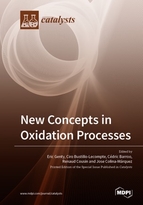New Concepts in Oxidation Processes
A special issue of Catalysts (ISSN 2073-4344). This special issue belongs to the section "Environmental Catalysis".
Deadline for manuscript submissions: closed (30 April 2018) | Viewed by 37088
Special Issue Editors
Interests: heterogeneous catalysis; total catalytic oxidation; mixed oxides; hydrotalcite like compounds
Interests: advanced oxidation processes; water, soil, and air quality; advanced treatment of water and wastewater; heterogeneous catalysis
Special Issues, Collections and Topics in MDPI journals
Interests: surface science; environmental microscopy; heterogeneous catalysis; nonlinear chemistry; nanocatalysis
Interests: VOC total oxidation; heterogeneous catalysis; environmental catalysis
Special Issues, Collections and Topics in MDPI journals
Interests: heterogeneous catalysis; thin films and nanotechnology; chemical reaction engineering; adsorption; industrial wastewater treatment by solar photocatalysis; novel material synthesis for advanced oxidation processes applications
Special Issues, Collections and Topics in MDPI journals
Special Issue Information
Dear Colleagues,
The oxidation processes in the field of catalysis take a major role in both industrial chemistry and environmental protection. Indeed, for the latter, the total oxidation reactions of volatile organic compounds (VOCs) and hydrocarbons is critical for pollution control in industrial processes and mobile sources. The presence of a mixture of organic and inorganic compounds (e.g., CO, VOC, NOx, SOx, among others) affects the difficulty to obtain stable, active, and selective catalytic materials. A second way to eliminate these pollutants corresponds to the selective oxidation of these to produce highly valuable chemical compounds such as fuel and alcohols. This methodology has also been used to produce chemical compounds from biomass. Moreover, the development of the photocatalytic or plasma catalysis techniques permits the intensification of low-energy processes.
This Special Issue of Catalysts aims at covering recent progress and novel trends in the field of catalytic oxidation reaction. Topics to be addressed in this special issue include the influence of different parameters on the catalytic activity at various scales (atomic, laboratory, pilot, or industrial scale), the development of new catalytic material of environmental or industrial importance, as well as the development of new methods, both microscopic and spectroscopic, to analyze oxidation processes.
Authors with expertise in these topics are cordially invited to submit their manuscripts to Catalysts. Significant full original papers and review articles are welcome.
Dr. Eric Genty
Dr. Ciro Bustillo-Lecompte
Dr. Cédric Barroo
Prof. Dr. Renaud Cousin
Prof. Dr. Jose Colina-Márquez
Guest Editors
Manuscript Submission Information
Manuscripts should be submitted online at www.mdpi.com by registering and logging in to this website. Once you are registered, click here to go to the submission form. Manuscripts can be submitted until the deadline. All submissions that pass pre-check are peer-reviewed. Accepted papers will be published continuously in the journal (as soon as accepted) and will be listed together on the special issue website. Research articles, review articles as well as short communications are invited. For planned papers, a title and short abstract (about 100 words) can be sent to the Editorial Office for announcement on this website.
Submitted manuscripts should not have been published previously, nor be under consideration for publication elsewhere (except conference proceedings papers). All manuscripts are thoroughly refereed through a single-blind peer-review process. A guide for authors and other relevant information for submission of manuscripts is available on the Instructions for Authors page. Catalysts is an international peer-reviewed open access monthly journal published by MDPI.
Please visit the Instructions for Authors page before submitting a manuscript. The Article Processing Charge (APC) for publication in this open access journal is 2700 CHF (Swiss Francs). Submitted papers should be well formatted and use good English. Authors may use MDPI's English editing service prior to publication or during author revisions.
Keywords
- Total Oxidation
- Selective Oxidation
- Advanced Oxidation Processes
- Photocatalysis
- Operando Study
- Biomass
- Hydrocarbon
- VOC








